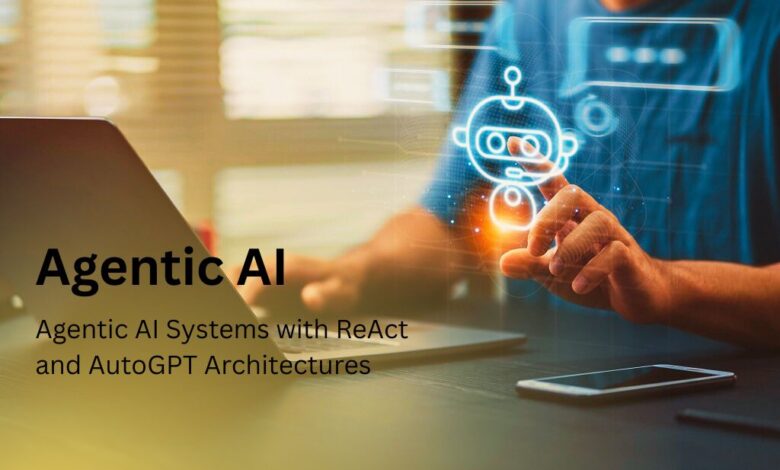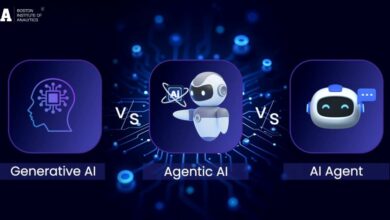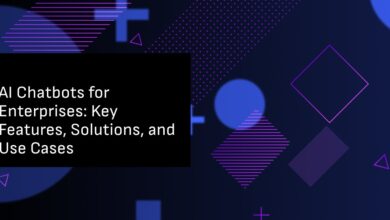Designing Agentic AI Systems with ReAct and AutoGPT Architectures

Agentic AI is no longer an idea locked away in research papers; it is now shaping real-world systems to automate decisions and collaborate with humans more efficiently than ever before. If you are serious about understanding and building such systems, two names will come into your knowledge: ReAct and AutoGPT. These are not hype words; they are building blocks of the next generation of autonomous agents.
This article will go into a detailed explanation about what Agentic AI actually means, the working of ReAct and AutoGPT architectures, and how you can learn to service the design of your Agentic AI systems through the Agentic AI Course at the Boston Institute of Analytics.
What Is Agentic AI?
Agentic AI refers to artificial intelligence systems operating with a sense of autonomy or goal-directed behaviour. These are perhaps the types of systems which, differing with traditional AI models, do not merely operate by rules which are predefined or simply react to inputs; rather, agentic AI systems make decisions, perform actions, adapt to changes in their environment, much like independent agents. These systems keep initiating events, judging the outcomes of the actions so initiated, and rearranging the assignments in farther accomplishing of the given targets.
How It Differs from Conventional AI?
Most conventional systems, like chatbots or recommendation engines, behave largely against agentic AI, in that they sit near to passive-they require a prompt, they do not go ahead and take initiative! Agentic AIs, on the other hand, have been designed with agency-capable of prioritizing tasks, making trade-offs, or taking initiative on their own without continuous input from humans. This makes agentic AI best suited for complicated, dynamic arenas such as robotics, autonomous vehicles, and personal AI assistant.
Applications of Agentic AI
Agentic AI finds operation where auto-decision is vital. In healthcare, agentic AI can monitor patient data and alert for intervention. In enterprises, it can schedule meetings autonomously, conduct workflows, or oversee supply chains. The real value here is that it is able to act alone while remaining engineered to facilitate the user’s intent.
Looking Ahead
With the evolution of AI, agentic AI will increasingly become the basis for more intelligent, helpful, and proactive systems. When ethically designed and safeguarded, it promises to change our way of interaction with machines and the automation of real-world tasks.
ReAct: Reasoning + Acting
ReAct stands for Reasoning + Acting, an AI framework in which logic meets interactive behaviour so that models can perform tasks. Instead of simply giving an answer, this AI can reason through problems step-by-step and take actions concurrently such as making an API call, issuing a database query, or padding to the web to get more information or to realize a goal.
How It Works?
With ReAct, the AI reasoning and acting are not disjoint: it switches back and forth between both activities. For instance, when asked some complex things, the ReAct agent would probably try to justify logically about the problem at hand, then use a tool (calculator, search engine) to get some missing pieces of information, and in the last step synthesize the information to provide a correct answer.
Why It Matters?
Existing traditional AI models either (1) have reflexive reasoning (e.g., ChatGPT reasoning that does not engage with the real world) or (2) act (to various degrees) with limited reasoning (e.g., rule-based bots). ReAct (reasoning followed by action) offers a way to blend the two modalities so that AI systems are more capable, adaptive, and useful in a dynamic environment. ReAct offers compelling systems, especially for tasks that require multi-step problem solving, research, autonomous agents, and decision-making.
The Future of ReAct Systems
ReAct is a building block of more agentic and intelligent AI. ReAct engages the Q&A model to focus on the development of advanced and intelligent systems that are goal-driven, can plan, reason, and execute with a high degree of autonomy.
Example Flow
- Prompt: “Find the best laptop under $1000 for programming.”
- Reason: “I should check popular tech sites for reviews and filter by price and performance.”
- Act: Performs a Google search or queries a product API.
- Observe: Gets list of laptops and features.
- Reason: “Based on these specs, the Lenovo IdeaPad Slim is the best option.”
- Final Answer: “The best laptop under $1000 for programming is…”
This cycle of thought and action allows the AI to behave much more like a human researcher or assistant.
AutoGPT: Autonomous Task Execution
AutoGPT is an enhanced version of agentic AI, representing an autonomous AI system capable of executing complex tasks on its own, without the need for continuous human input. At its core, AutoGPT is based on large language models, such as GPT, and self-initiates the breakdown and completion of a clearly defined goal by the user into a series of sub-tasks in a step-wise fashion, refining its processes by the feedback of previous actions and any resulting outcomes.
How It Works?
For instance, if a user states a goal to AutoGPT, such as “create a marketing strategy for my new product,” AutoGPT will start by reasoning with the objective. It will then map a new plan of action, find out what needs to be completed based on user input (such as researching competitors, creating ad copy, designing a social media calendar etc.), and then it will take an action using the connected tools at its disposal including web browsers, APIs, or a file system. AutoGPT will continue to work through the cycle and be able to think through the steps and take actions until the user-defined goal is reached or it requires further commands/input from the user.
Why AutoGPT Matters?
AutoGPT is the next step toward agents that are truly autonomous. Whereas passive chatbots and command-based tools stay in the service of a user, this new breed does real-world tasks automatically. An especially powerful tool for entrepreneurs, researchers, and developers who want to make an AI take on complex projects such as data analysis, content creation, or software testing, with very little oversight.
The Future of Autonomous Agents
AutoGPT is really laying the path for AI systems in the future that can go along as independent collaborators. As capabilities grow, these autonomous agents will start handling workflows along with scaling businesses and providing a machine-based transformation in daily life interaction.
It uses a combination of:
- Memory systems (short-term and long-term)
- Tool use (like web browsing or code execution)
- Self-feedback (evaluating what worked and what didn’t)
- Autonomous loops (running continuously until a goal is reached)
Real Use Cases
- Writing and deploying code.
- Market research and competitor analysis.
- Customer support automation.
- Managing social media or content creation workflows.
AutoGPT turns Agentic AI from a theory into an engine that can think, plan, act, and adapt without handholding.
Designing Agentic AI Systems: A Step-by-Step Framework
- Define the Objective
First, identify the high-level goal that the agent has to fulfill. This may be as general as booking appointments, managing inventories, or conducting researches. The actual purpose, when clearly defined, guides the reasoning of both system and action loops all along the way. - Break Down the Task
Dissect the larger purpose into sub-tasks. This modularized approach allows the agent to work through a defined workflow, follow progress, and initiate changes when required. Tasks should be logically ordered and flexible. - Equip the Agent with Tools
An agentic AI system has to gain external tool access—say, web browsers, APIs, file systems, or databases—to, somehow or another, operate meaningfully in the real world. This artificial agent, upon this integration, will be location ally enabled to fetch needed data, perform calculations when required, communicate externally, and so forth. - Implement ReAct (Reasoning + Acting)
It is necessary to set up a ReAct loop within the system so the agent can reflect and then act on that reflection, sometimes multiple times. This reflective-action dynamic leads the agent toward solving multi-step problems and arriving at decisions in the present moment. - Enable Memory and Learning
Incorporate short-term memory and long-term memory modules. Short-term memory keeps track of the current context of the conversation or task, whereas long-term memory allows the agent to learn from past experiences and reshape its future behaviour. - Monitor, Evaluate, and Refine
Second, add monitoring mechanisms to evaluate the agent’s decisions and actions. Alternatively, set up feedback loops and build-in human-in-the-loop systems to correct errors and improve agent performance over time. - Ensure Ethical and Safe Operation
Finally, safeguards should be put in place, including permission checks, ethical constraints and data privacy controls. The agentic AI shall be a manifestation of human values: transparent and without unintended consequences.
Why You Need a Structured Learning Path: The Agentic AI Course
Agentic AI is a very fast-moving area that combines reason, autonomy, and action. Without a concrete learning procedure, one may well get completely lost in scattered tutorials, library papers, and disjointed tool documentation. A good Agentic AI course will completely clarify the situation, gently leading through the tutorial step by step by explanation with formal concepts ReAct (Reasoning + Acting), autonomous execution of tasks, tool integration, and agent frameworks such as AutoGPT or LangChain.
Hands-On Skill Building
Given in a structured path, the course should guide you in absorbing theory but most importantly applying it, from simple reasoning agents to full-fledged autonomous systems. With the right curriculum contemplating the right projects at the right time, you should be confident in developing and eventually deploying your own agentic AI solutions.
Avoiding Costly Mistakes
Agentic AI involves decisions around architecture, safety, memory, and ethics. Learning in an unstructured way can lead to mistakes that are hard to debug or scale. A guided course highlights best practices, common pitfalls, and safe implementation strategies—saving you time and frustration.
Staying Ahead of the Curve
Agentic AI makes decisions on architecture considerations, safety worries, memory choices, and ethical questions. If destined in an unstructured format, options would be a recipe for disaster, not even knowing where to begin. A good course will point out what to do and common pitfalls while giving you strategies to implement a safe version—you will thank me for saving you all that time and frustration.
Final Thoughts: Agentic AI Is the Future Don’t Watch It Pass You By
Language models have given rise to a novel form of AI system-building. But the future will belong to agents that evaluate, plan, act, revise, and execute.
Understanding ReAct and AutoGPT is thus one of the primary doorways to developing such systems. But beyond knowing the technology, you have to be properly trained and guided in its application.
Agentic AI Course at Boston Institute of Analytics has everything to equip you with the toolkit, mentorship, and hand-on experience to go from watching the AI wave as a passive observer into building and deploying systems that are shaping this wave.






